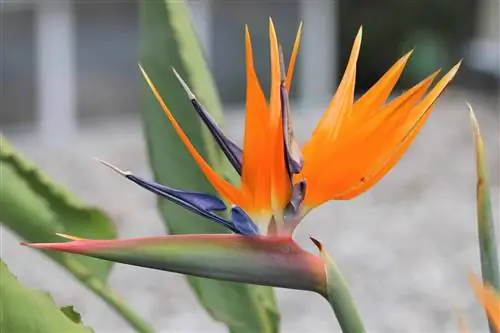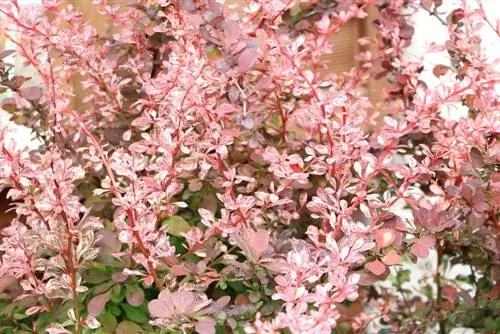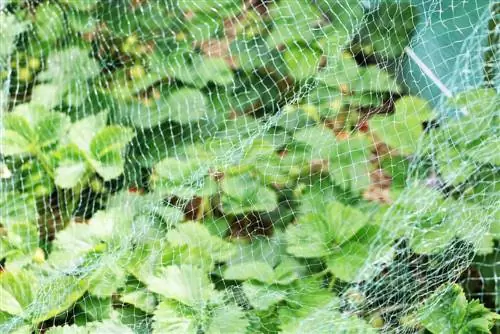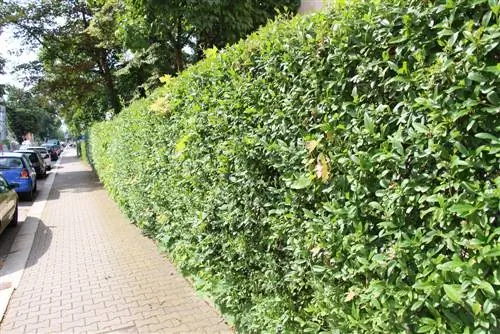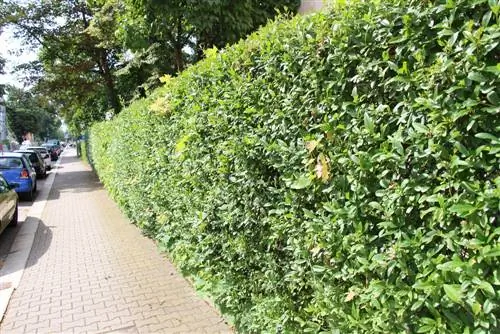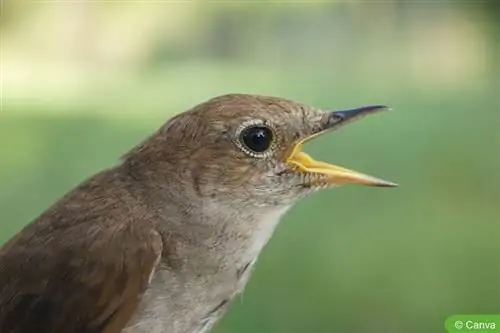- Author admin [email protected].
- Public 2023-12-17 03:39.
- Last modified 2025-01-24 12:45.
The bird of paradise flower, also known as the parrot flower, grows very often on the Canary Islands and Madeira. There, the flower with its bizarre appearance thrives outdoors and is grown as a cut flower for export.
The name refers to the petals that emerge from the beak-like covering. The petals of Strelitzia reginae are orange-yellow or gentian-blue. There are also other species in other colors, the scent of the flowers is not particularly pronounced. The plant grows upright to a height of 1 ½ meters; dwarf varieties do not grow taller than 75 cm. The leaf with its long shafts, which are elongated towards the tip, is very decorative. It is blue-gray and closely resembles that of the banana plant. This is no coincidence, as the plant belongs to the banana family, Musaceae.
Care at a glance:
- Location: bright and full sun
- Water requirement: high in summer, low in winter
- Fertilizing: only in the summer months
- Substrate: conventional potting soil
- Wintering: bright at 10° to 15°C
- Repotting: if necessary in spring
Care and wintering
In our greenhouse it blooms in winter or spring, and very rarely in autumn. The Strelitzia can be easily grown from seeds - although the germination time is sometimes 6 months. Flowering only occurs after 2-4 years. The plant can be placed on the balcony or terrace in summer. It overwinters at 10-12°C.
The Strelitzia tolerates light and full sun outdoors. Water abundantly in summer and fertilize once a week with liquid fertilizer. Water much more sparingly in winter. The plant thrives best in normal potting soil or in a mixture of equal parts of rubbed garden soil, leaves and coarse gravel. You may be able to add 10% charcoal. If necessary, transplant in spring. A special cut is not necessary, but you should thin out the leaves from below if the pot is too tight.
Propagation & Sharing
The bird of paradise flower is propagated by sowing seeds or by dividing larger plants: Divide a large plant carefully. This will be done in the spring. This way you can get flowering plants faster than by sowing seeds.
Sowing
Seed soil or a mixture of equal parts sand and potting soil should be used as the growing medium. The seeds germinate best at temperatures of 24-25°C. After germination, the plants are placed in a mixture of equal parts of strong mulch, leaf compost and coarse gravel. It is essential to ensure good drainage - waterlogging is difficult to tolerate.
Diseases
- The Strelitzia is rarely affected by diseases.
- For winter storage, the specified temperatures and watering advice should be strictly followed.
- If gray mold spreads, it must be sprayed with a fungal agent.
- If the plant gets too much water in winter, it can suffer from root rot - immediately water less.
- If gray mold spreads, it must be sprayed with a fungal agent.
Problems with flowering
If a Strelitzia doesn't bloom, it may be because it is too young. Plants grown from seeds take about six years to produce their first flowers. In this case, some patience is required. On older plants, however, too much fertilizer can be the cause of a lack of flowering. Excessive fertilization promotes leaf growth but not flower formation. Reducing or stopping fertilization could therefore lead to success. Even if the location is too dark, no flowers will form because the Strelitzia originally comes from South Africa, although many people are more familiar with it from the Canary Islands. It is therefore very hungry for sun and needs a location that is as bright as possible.
Be careful when repotting, as the roots can easily be injured. If this has happened, it may well be that the Strelitzia will not bloom the following year. However, it will recover if its roots have not been damaged too badly and it is otherwise well cared for. The timing of flowering depends primarily on the temperature during overwintering. The warmer the bird of paradise flower is in winter, the earlier it blooms. However, a certain period of rest at a low temperature is necessary for a new flower to form.
The bird of paradise flower is ideal as a cut flower for the vase. Your flowers will last longest if the vase is bright, but not in direct sunlight and in a relatively cool room.

